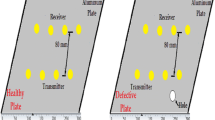Abstract
A method using the support vector machine (SVM) to detect local damages in a building structure with the limited number of sensors is proposed. The SVM is a powerful pattern recognition tool applicable to complicated classification problems. The method is verified to have capability to identify not only the location of damage but also the magnitude of damage with satisfactory accuracy. In our proposed method, feature vectors derived from the modal frequency patterns are used. The feature vectors contain the information on the location and magnitude of damages. As the method does not require modal shapes, typically only two vibration sensors are enough for detecting input and output signals to obtain the modal frequencies. The support vector machines trained for single damage is also effective for detecting damage in multiple stories.
Similar content being viewed by others
References
Doebling, W., Farrar, R., Prime, B., and Shevitz, W. (1996). “Damage Identification and Health Monitoring of Structural and Mechanical Systemes from Changes in their Vibration Characteristics: a Literature Review.” Los Alamos National Laboratory.
Ko, J.M. and Wong, C.W. (1994). “Damage Detection in Steel Framed Structures by Vibration Measurement Approach.”Proceedings of 12 th International Modal Analysis Conference, pp. 280–286.
Loh, C.H. and Tou, I.C. (1995). “A system identification approach to detection of changes in both linear and non-linear structural parameters.”Earthquake Engineering and Structural Dynamics, Vol. 24, pp. 85–97.
Mita, A. (1996). “Distributed health monitoring system for a tall building.”Proceedings of 2nd International Workshop on Structural Control, pp. 333–340.
Mita, A. (1999). “Emerging Needs in Japan for Health Monitoring Technologies in Civil and Building Structures.”Proc. Second International Workshop on Structural Health Monitoring, Stanford University, pp. 56–67.
Morita, K., Teshigawara, M., Isoda, H., Hamamoto, T., and Mita, A. (2001). “Damage Detection Tests of Five-Story Frame with Simulated Damages.”Proceedings of the SPIE vol. 4335, Advanced NDE Methods and Applications, pp. 106–114.
Nakamura, M., Takewaki, I., Yasui, Y., and Uetani, K. (2000). “Simultaneous identification of stiffness and damping of building structures using limited earthquake record.”Journal of Structural Construction Engineering, Vol. 528, pp. 75–82. (in Japanese).
Nello, C. and Shawe-Taylor, J. (200?).An Introduction to Support Vector Machiens: And Other Kernel-Based Learning Methods, Cambridge Univ. Press.
Pandey, A. K. (1991). “Damage detection from changes in curvature mode shapes.”Journal of Sound and Vibration, Vol. 145, No. 2, pp. 321–332.
Vapnik, V. N. (1995).The Nature of Statistical Learning Theory, Springer.
Verhaegen, M. and Dewilde, P. (1992). “Subspace model identification part 1. The output-error state-space model identification class of algorithms.”international Journal of Control, vol. 56, No. 5, pp. 1187–1210.
Zhang, Z. and Aktan, A.E. (1995). “The Damage Indices for the Constructed Facilities.”Proceedings of the 13 th International Modal Analysis Conference, pp. 1520–1529.
Author information
Authors and Affiliations
Corresponding author
Rights and permissions
About this article
Cite this article
Mita, A., Hagiwara, H. Quantitative damage diagnosis of shear structures using support vector machine. KSCE J Civ Eng 7, 683–689 (2003). https://doi.org/10.1007/BF02829138
Issue Date:
DOI: https://doi.org/10.1007/BF02829138




